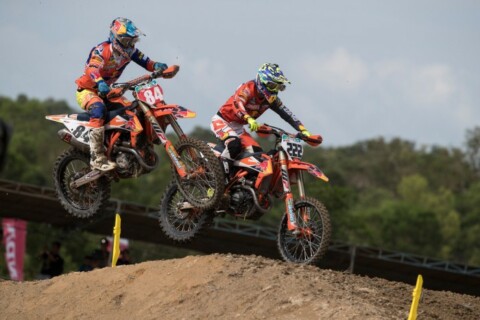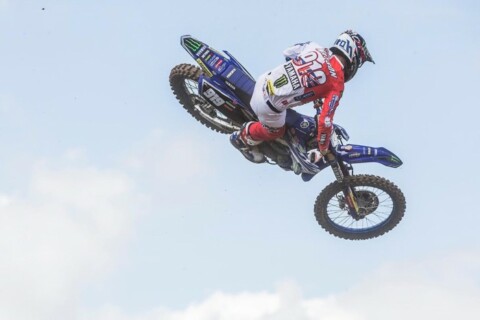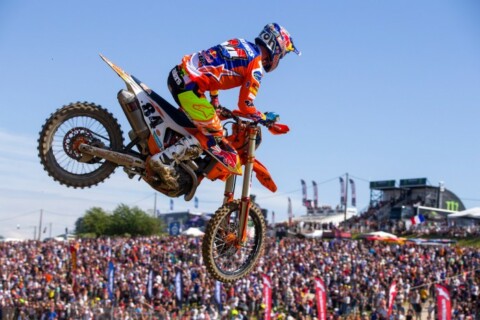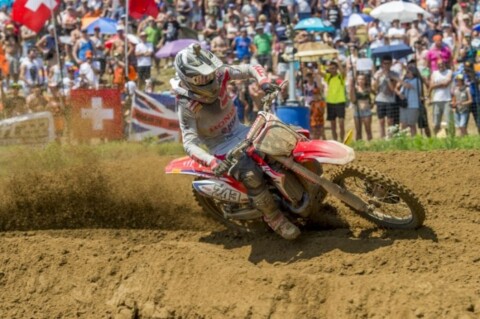Honda has today unveiled its new CRF450R which has benefitted from an increase in power and torque, and get a three-stage launch control system direct from HRC.
Two years ago the bike was effectively a brand-new machine, wielding a major power boost from a brand-new engine, plus increased grip and drive from a completely redesigned chassis.
It looked different from the CRF450Rs that had gone before, felt different and delivered a whole new experience on track. In 18YM the addition of standard-fit electric start (an option for 17YM) completed the package.
But the relentless demands o competition mean that, year by year, even the best bikes have to get better, and for 2019, the CRF450R is getting a straight shot of HRC works technology with major upgrades that make it faster still.
Motor
While the architecture of the 449cc four-valve Unicam engine remains essentially unchanged – apart from removal of the kickstart – a host of detail changes deliver the increase in power and torque.
And while the peak boost is significant - 2.4bhp more power at 9500rpm and 1.5 more torques at 7500rpm - it has not been achieved at the expense of low-down performance: the strength of the YM19 engine’s power and torque curves from 3,000rpm up are well above the previous design, and corner-to-corner over-rev has also been enhanced.
Bore and stroke remains 96mm x 62.1mm with compression ratio of 13.5:1. Combustion chamber squish has been revised, as has the piston skirt profile, piston ring and conrod; both right and left engine cases have been optimised for strength versus weight.
A new air cleaner element base has more than double the surface area, and flows much more air as a result; revised PGM-F1 settings make use of the improved air flow, and the system now injects fuel twice per cycle. In step with the improved engine output, a revised radiator grill improves air flow for maximum radiator efficiency. A gear position sensor allows the use of three specific ignition maps for 1st and 2nd, 3rd and 4th, and 5th.
The exhaust too now uses differing, larger diameter bores where it splits from the downpipe; 35mm right and 42mm diameter left (both were 31.8mm before). And the total length of the left side exhaust – from port to tip – has been increased 187mm, with the right muffler tube 98mm longer.
Launch control
HRC’s Launch Control system gives any rider the best option for a strong start and has 3 modes to choose from:
Level 3 – 8,250rpm, muddy conditions/novice
Level 2 – 8,500rpm, dry conditions/basic
Level 1 – 9,500rpm, dry conditions/expert
Activating HRC Launch Control is easy – to turn on, pull in the clutch and push the Start button (on the right). The LED will blink once for Level 1 selection. Push the Start button again, for 0.5s or longer, and the LED will blink twice for Level 2. Repeat the process and the LED will blink 3 times, indication Level 3 has been chosen.
Honda’s EMSB (Engine Mode Select Button) puts instant engine character adaptability at the rider’s control. With the machine stopped, and engine at idle, a simple press and hold of the button for just under a second selects the next map in sequence.
The LED built into the button signals the map in use with a quick press and number of subsequent flashes (like HRC Launch Control, 1 flash for Mode 1, etc). If a new map is selected the choice is also confirmed to the rider.
Mode 1 uses the standard combination of ignition and fuelling maps to present a balanced power and torque delivery. Mode 2 is more mellow in nature, giving easy-to-manage throttle feel. Mode 3 hits sharply, with aggressive and responsive power. Mode 2 and 3 can be further tailored via the existing HRC setting tool for mapping hardware and software.
Chassis and brakes
the CRF450R’s chassis has also improved in step, with even better balance, turning ability and tracking through a corner. 0.9kg has been shaved from the weight figure (dry weight is now 107.6kg, wet weight 112.3kg) while suspension action front and rear has been revised. Rake and trail are set at 27.4°/116mm, with wheelbase of 1482mm.
The tapered twin-spar frame design has been slimmed and lightened around the swingarm pivot plates – the swingarm, too has been subtly re-shaped, is lighter and features a lower rigidity balance to improve traction and feel. The rigidity of the right and left cylinder head hangers has also been optimised. A tiny detail – that also saves 20% weight – are the footpegs, which now use a 4-web (rather than 6) internal structure to clear mud.
The fully adjustable 49mm Showa USD coil spring fork is a version of the Showa ‘factory’ fork supplied to MX race teams in the Japanese championship.
For YM19 spring rate, compression/damping settings and oil weight have been revised. The fully adjustable Showa rear shock has received a ‘Super Finish’ treatment, which improves its stroke action. A revised Pro-Link ratio softens slightly as it reaches full compression.
The new Renthal Fatbar reduces the weight of the steering system and flexes for optimal comfort; the top yoke features two handlebar-holder locations for moving the handlebar rearward and forward by 26mm. When the holder is turned 180 degrees, the handlebar can be moved an additional 10mm from the base position, resulting in four total unique riding positions. A Bar Pad is also included.
A new twin-piston front brake caliper uses 30 and 27mm diameter pistons (the previous design used 2 x 27mm pistons). This allows for a lighter body and, along with low expansion-rate brake hose, improves brake feel and power. It works on a 260mm wave-pattern disc, matched by a rear 240mm wave-pattern disc and single-piston caliper.
Lightweight DID aluminium rims, with directly attached spoke pattern layout are now finished in black; the front is a 21 x 1.6in, the rear a 19 x 2.15in. Fitted as standard equipment are Dunlop’s MX3SF and MX3S soft terrain tyres.
The CRF450R uses a lightweight 6.3L titanium fuel tank. The smooth external lines of the plastics help the rider move easily, and the narrow frontal area and front mudguard directs an efficient funnel of air to the radiator – for YM19 the radiator grills have been redesigned to flow more air. The bodywork uses durable film inset graphics that cover a wide area with scratch-resistant style.










